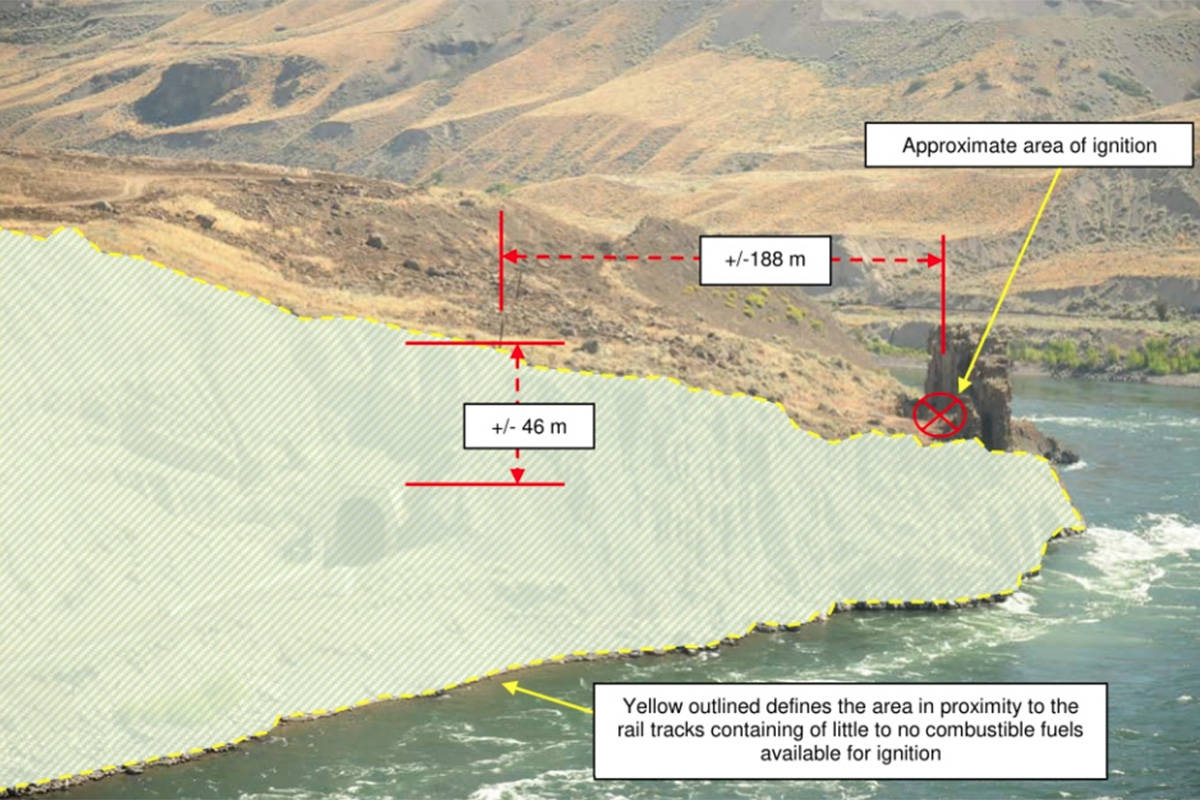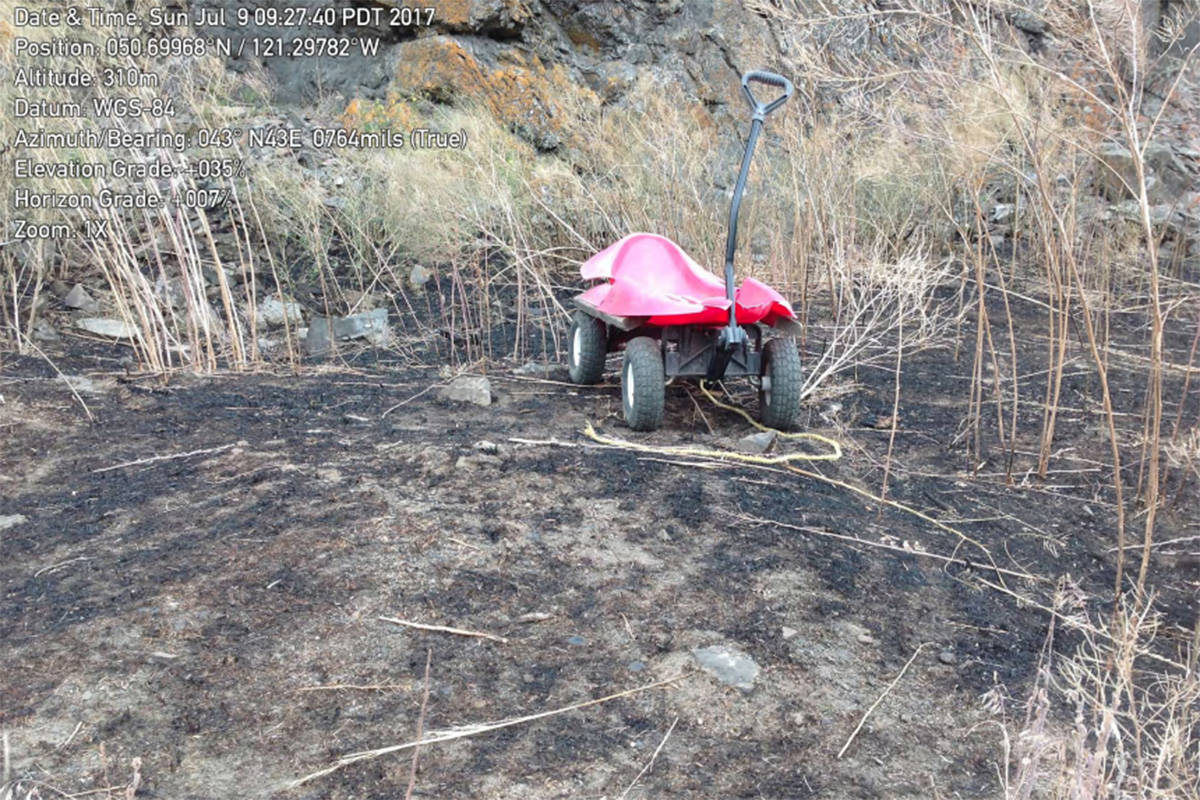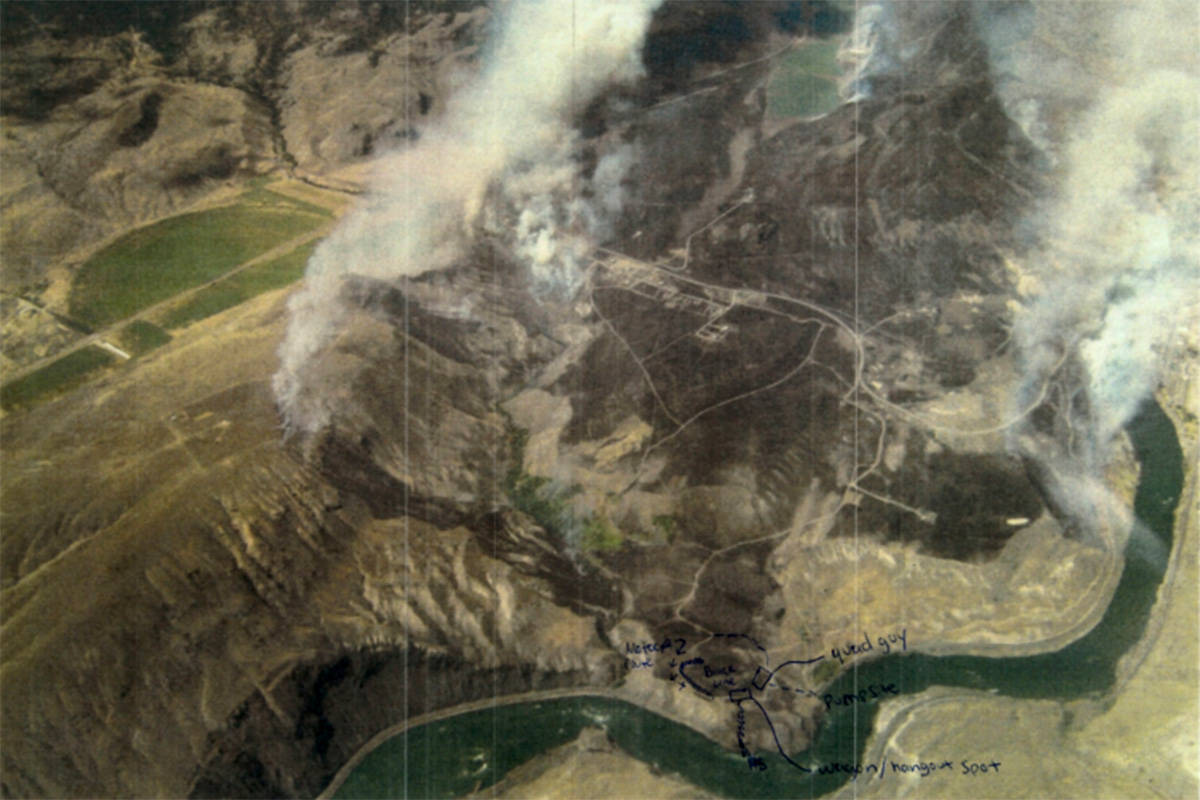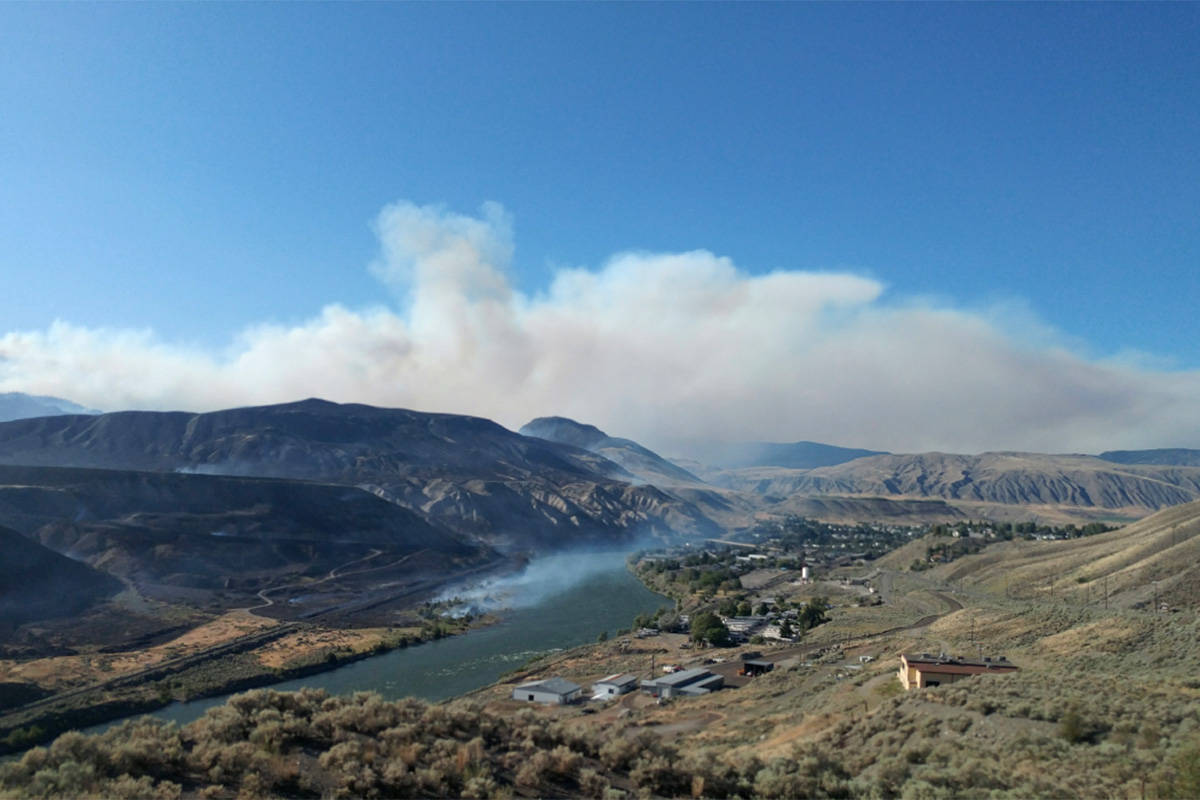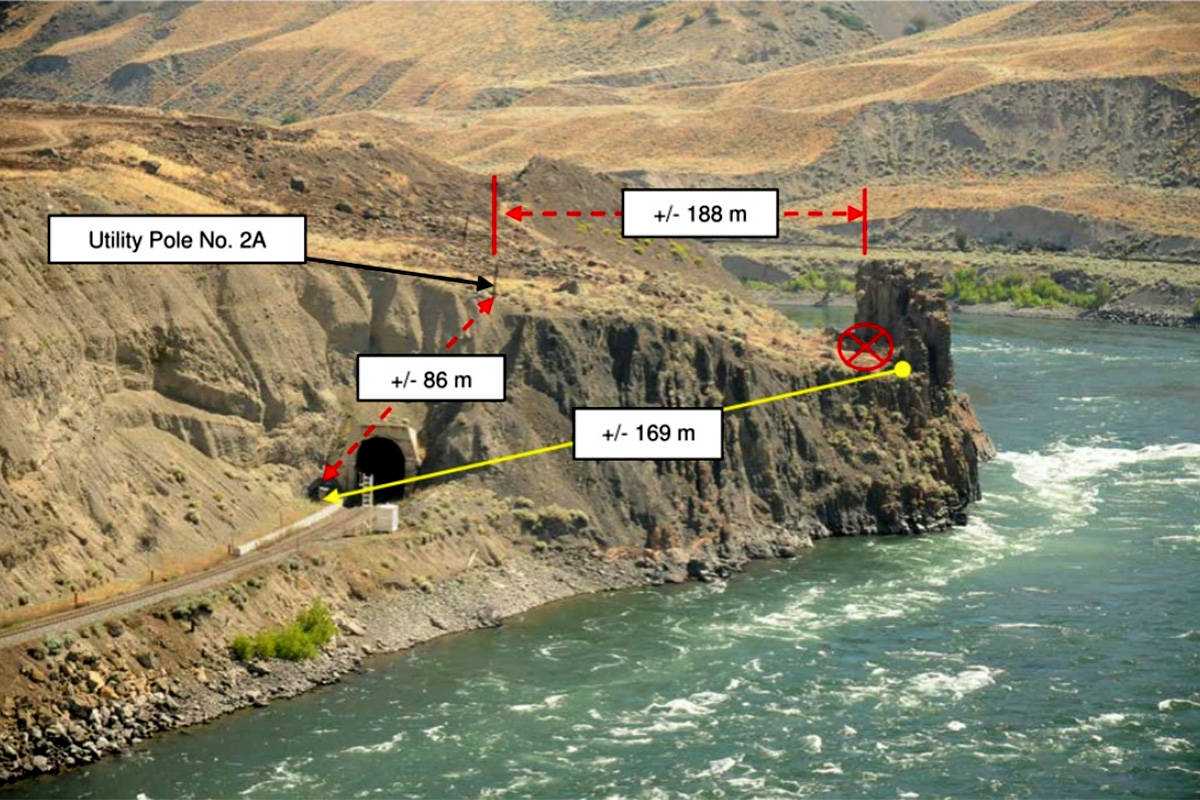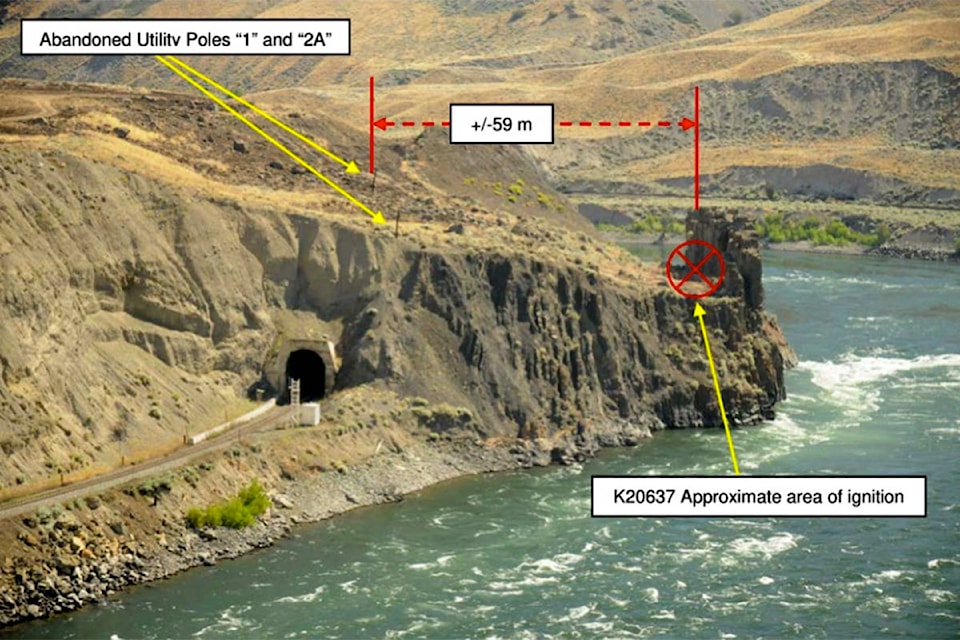A Freedom of Information Request into the Elephant Hill wildfire, which burned more than 190,000 hectares and destroyed 45 homes in 2017, offers a closer look at the ignition site, time, cause, and investigation of the fire.
An aerial photograph indicates the fire started near one of the bends of the Thompson River southwest of Ashcroft, 46 metres above a train tunnel on the CN mainline. The fire is estimated to have started between 8:30 and 9:30 p.m. on Thursday, July 6, with the first report of a fire in the area recorded at 9:57 p.m.:
“Caller is in Ashcroft, looks like a fire in Black Canyon on W side of river, S of Ashcroft, seeing smoke not flames. Smoke: white. Size: house. Spread: yes - slowly. Fuel: probably brush and grass.”
The size of the fire was recorded as 4.3 hectares as of 3 a.m. on Friday, July 7 by BC Wildfire Service employee Sean Owens, the incident commander on the fire, who noted in his Field Fire Report “Continuing blackline (15 ft) around west and northwest.” By 7 a.m. the blackline was around 35 per cent of the fire area: “no growth” wrote Owens.
At 9 a.m. the blackline was around 40 per cent of the fire on the west and northwest: “N, E, S guarded by slope down to river minimal fire behaviour.” By 10:30 a.m. Owens noted that a hoselay through the fire from the Thompson River was complete.
Crew leader Martin Whitney received handover of the incident at 10:40 a.m. His handwritten notes state that at 11:20 a.m. “Activity picked up. Immediate [illegible] requested & helicopter bucket support also requested additional crew.” At noon he writes “began evacuating homes also asked for B.C. Hydro and Cache Creek fire department.”
Another crew member’s notes record that at noon on July 7 “fire has escaped control lines due to excessive winds.” At 1:21 p.m. he noted “have discussed need for evac of Cache Creek.” It was not until Sept. 27 — 83 days later — that the Elephant Hill wildfire was listed as 100 per cent contained. By that time it had consumed more than 192,000 hectares of land and destroyed dozens of houses and other structures.
The information obtained under the FOI request shows the various possible causes of the fire and the results of the investigation.
Lightning was ruled out, with only a single strike approximately 31.1 km south of the ignition site recorded in the week leading up to the fire. Investigators noted they did not see any recent campfire or campfire ring near the ignition area. They also did not observe any signs of Category 2, 3, or Resource Management Open Fires, and there were no active fire registrations for that general area, with the most recent registration having expired in 2003.
According to the FOI, 15 items were collected as evidence, but none of those suggested the items were used to ignite a fire to cause damage to property or that the fire was ignited for criminal purposes. A red plastic child’s wagon seized at the area of ignition, as was fishing equipment, which showed that people had been there recently, according to the report.
There was also no evidence of heavy equipment use, and another photo shows that the ignition site was 188 metres from the entrance of a CN railway tunnel, which was also another 46-metre vertical drop below the site.
The BC Wildfire Service received an email from someone stating they heard the train screeching by; the writer noted that “I could hear the sparks it made.” Further investigation, however, suggested the estimated time of ignition was close to 80+ minutes before the train was heard. The report also noted that metal sparks created from train wheels have a maximum horizontal flight distance of about 11 to 12 metres, meaning they could not have travelled the 46m and 188m to the area of ignition. There was also no fire, and no burned areas, between the rail bed and the height of land above the tunnel entrance.
While there was a motorcycle track near the ignition area, that appeared new. However, investigators concluded the fire travelled towards the motorcycle track and not from it.
The nearest active utility lines were 1.5 km away along Cornwall Road. Three nearby abandoned poles were not in service.
In the section of the report headed “Discarded Match or Smokin Substance”, it was noted that these were defined as “matches, cigars, pipe tobacco, cigarette, and or illegal substances”. The report continues “For a cigarette to be a competent ignition source in igniting forest fuels, a number of environmental conditions must exist at the time the cigarette comes in contact with these fuels. All of the environmental conditions must exist at the same time for ignition from a cigarette to be possible.”
The specific conditions required are a temperature of ≥26.0°C, relative humidity (RH) of ≤22%, a fuel moisture (FM) of ≤14%, or a fine fuel moisture code (FFMC) of ≥87. “Using observations recorded by the Environment Canada weather station located in Ashcroft BC, the specific conditions required for a cigarette to ignite forest fuels was present for 12 hour period beginning at 1100hrs [11 a.m.] July 6th and continuing until 2300hrs [11 p.m.] July 6th.”
The weather station figures show that at 1300hrs (1 p.m.) on July 6, the temperature was 28.3°C, the relative humidity was 16%, the fuel moisture was 03.8%, and the fine fuel moisture code was 97.2%.
said that at 6:30 a.m. on July 7 “a guy came by on a quad and stopped to talk to the Initial Attack Crew. The guy says he hoped it wasn’t his cigarette that lit the fire, mentions he put cigarette out ‘properly’ on the rocks, thought he was careful, lives nearby, surprised there’s a fire; people never go down there.”
Owens’s notes read that the person on the quad “stopped and talked said he worked on Lytton UC [unit crew, meaning the person had wildfire-fighting experience] was ‘concerned his cigarette the previous night had started’ it though he had ‘been careful’ and put it out properly, was on rock bluffs not in grass. Helped us find pump site then left.”
Another person riding a motorbike with a full-face helmet also “ripped by” the crew without stopping on July 7, according to Owens. Based on those statements and notes, a discarded match or smoking substance was included as a cause. The report notes a three-part grid search consisting of a visual search, magnetic search, and final sifting of all debris within the grid was carried out. “No cigarette, cigarette remains or smoking materials were found or observed.”
There were some firearm cartridges but they did not appear to be recent, according to the report.
The report listed the cause as undetermined but noted it “is most likely the result of smoking and smoking materials, as all other causes have been excluded.”
https://www.scribd.com/document/469517843/Elephant-Hill-wildfire
newsroom@100milefreepress.net
Like us on Facebook and follow us on Twitter.
